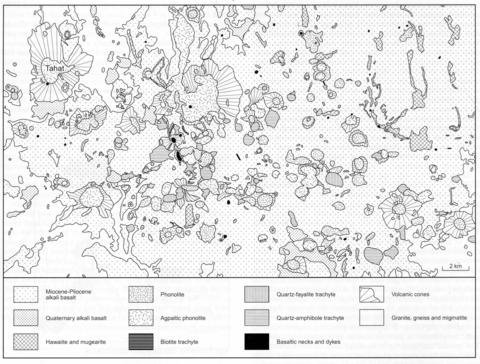stripes
The Atakor volcanic field extends over 2150 km2 and has an estimated volume of 250 km3 (Girod, 1971). It lies on a 1 km high basement dome which is 80 km in diameter and culminates in Mont Tahat, the highest point in Algeria. The lavas lie on Precambrian granitic and gneissic rocks. The volcanic rocks comprise essentially two groups: basalts, hawaiites and mugearites, which generally form stratovolcanoes built up of lapilli and scoria from which issue flows up to 20 km in length, as well as necks and dykes, and phonolites and trachytes, which comprise cumulodomes, domes and spines. Atakor consists of southern and northern (known as Manzuz) fields and Girod (1971) calculates for the southern field, which he describes in detail, the proportions of the various rock types as basalt 80%, hawaiite and mugearite 2%, phonolite 13% and trachyte 5%. The basalts are all alkaline types and vary, according to Girod (1971), from ankaramite, through basanite to basanitoid; normative nepheline, but not modal, always occurs and analcime is often present. The basanites contain phenocrysts of olivine, salite and sometimes plagioclase (An40-65) in a matrix of the same minerals, analcime, biotite, alkali feldspar and opaques. In the basanitoids glass is relatively abundant and generally alkali feldspar and biotite are absent. Ankaramite forms necks and is characterized by the greater abundance (10-15%) and size (1-5 mm) of mafic phenocrysts. In some scoriaceous basanitic rocks of cinder cones kaersutite may be abundant, individual crystals up to 10 cm in length occurring, while zircon and scapolite may also be present in some pyroclastic rocks. Coarser varieties of basanite, essentially analcime dolerite, occur in several necks and dykes. Hawaiites are aphyric, trachytic in texture and characterised by the presence of andesine microlites, which generally comprise 50-60% of the rock, together with olivine, clinopyroxene, opaques, minor analcime and some apatite. The mugearites are similar but the feldspar is oligoclase. Cumulodomes and other structures of phonolite are concentrated in the southwestern part of the Atakor field and form the highest mountains. Some flows issue from the domes and these may reach 30-40 m in thickness but rarely attain 5 km in length. The extrusions of phonolite and trachyte take a range of forms which are described and illustrated by Girod (1971). The phonolites are classified by Girod (1971) into miaskitic and agpaitic types. The former comprise >80% anorthoclase, up to 11% clinopyroxene and 15% nepheline, a little analcime, minor resorbed amphibole, opaques, titanite and rare biotite and melanite. The agpaitic phonolites include >80% alkali feldspar, up to 12% nepheline, a little analcime, in some rocks hauyne, pyroxene, and minor or rare arfvedsonite, aenigmatite, lavenite, mosandrite, eudialyte and possible rosenbuschite. The trachytes are characterised by the presence of biotite, fayalite or arfvedsonite and all contain a little quartz. Alkali feldspar is dominant in all types, there is a little plagioclase (An23-27), opaques, apatite, titanite and sometimes garnet. The fayalite trachytes contain green pyroxene and some a little aenigmatite, which also may occur in the arfvedsonite trachytes, as may lavenite. Xenoliths are abundant in the basaltic rocks and Girod (1971) briefly describes granite, gneiss, norite, granulite, charnockite, peridotite and garnet pyroxenite. Lherzolite xenoliths are described by Girod et al. (1981) and spinel peridotites from the Manzaz area (northern Atakor) by Dupuy et al. (1986). Scapolite, kaersutite, oligoclase, titanomagnetite and clinopyroxenite inclusions have been described from the Segueika cinder cone by Boivin and Camus (1981). Numerous rock and mineral analyses and a detailed, coloured geological map of the central area are given by Girod (1971) and Pb-Nd-Sr isotope data on one alkali basalt by Allègre et al. (1981).
ALLEGRE, C.J., DUPRE, B., LAMBRET, B. and RICHARD, P. 1981. The subcontinental versus suboceanic debate, I. lead-neodymium-strontium isotopes in primary alkali basalts from a shield area: the Ahaggar volcanic suite. Earth and Planetary Science Letters, 52: 85-92.BOIVIN, P. and CAMUS, G. 1981. Igneous scapolite-bearing associations in the Chaine des Puys, Massif Central (France) and Akator (Hoggar, Algeria). Contributions to Mineralogy and Petrology, 77: 365-75.DUPUY, C., DOSTAL, J., DAUTRIA, J.M. and GIROD, M. 1986. Geochemistry of spinel peridotite inclusions in basalts from Hoggar, Algeria. Journal of African Earth Sciences, 5: 209-15.GIROD, M. 1971. Le massif volcanique de l'Atakor (Hoggar, Sahara Algérien). Étude pétrographique, structurale et volcanologique. Centre de Recherches sur les zones arides. Série Géologie, Éditions du Centre National de la Recherche Scientifique, Paris, 12: 1-158.GIROD, M., DAUTRIA, J.M. and GIOVANNI, R. de, 1981. A first insight into the constitution of the upper mantle under the Hoggar area (southern Algeria): the lherzolite xenoliths in the alkali basalts. Contributions to Mineralogy and Petrology, 77: 66-73.ROGNON, P., GOURINARD, Y., BANDET, Y., KOENIGUER, J.-C. and DELTEIL-DESNEUX, F. 1983. Précisions chronologiques sur l'évolution volcano-tectonique et géomorphologique de l'Atakor (Hoggar): apports des données radiométriques (K/Ar) et paléobotaniques (bois fossiles). Bulletin de la Société Géologique de France, Ser. 7, 25: 973-80.

